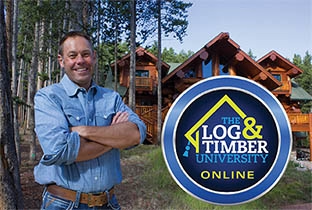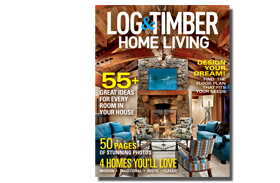
The power of the purse strings is pervasive. Financial considerations touch virtually every aspect of life, and the process of completing the log or timber home journey – from mere idea to move-in – is no exception. Getting a handle on what you can afford is among the earliest requirements for managing costs and minimizing the possibility of overruns or unnecessary expenses. We break it down for you in three key steps to guide you on that journey.
Step 1: Assessing the Situation
Michael Grant of Modern Rustic Homes sees cost considerations arise regularly as clients begin the construction process in earnest. “The cost of any home is based on what I call the five ‘L’s,’” he explains.“Lumber (in this case, logs and timbers); labor; lots (to include development expenses for access and infrastructure); legislation (how local, state and federal governments have added to expense); and loans, with interest rates that have escalated prohibitively in the past three to four years.”
Michael advises prospective homeowners to understand the cost of every component of their project. Keeping an eye on expenses, he says, is similar to daily weigh-ins to achieve a weight-loss goal. “Understand your contracted costs and honor your allowances,” he suggests. “One example is the cost of flooring. If you are all in for materials and installation at $10 per square foot, then know what your installation, labor and materials cost will be and don’t exceed it.”
Considering the project in its entirety, Coventry Log Homes’ Vice President Mark Elliott says a comprehensive cost evaluation is worthwhile early in the process. “The reality is that everyone has a budget they hope to stay within,” he reasons. “Even multi-million-dollar projects are concerned with affordability. Many of our customers work within very tight budget constraints and should typically expect to spend between $300 and $350 per square foot for a finished home, not including the land.”
Step 2: Dealing with Design vs. Desire
“Taking the time to design a plan that’s functional and well-thought-out can help save in the long run,” notes Mark. “We like to do an initial price estimate for the design and then make suggestions as to how the plan can flow better and maybe even save some money. There may also be tasks during the construction process you can do yourself to lower labor costs, such as staining the exterior of the logs or applying the interior finish.”
In fact, exercising care as you design your home and utilizing every space to its fullest can make a project more affordable — even generate previously hidden savings.
Mark sees great value in posing questions to his clients when affordability is the topic: “Does your primary bedroom need to be that large, or could it be smaller? Could a loft double as a bedroom for visitors when needed rather than having a dedicated guestroom? Have you considered utilizing the basement as part of the square footage of the finished space? We love to help clients get the details of a design exactly the way they want it.”
Step 3: Getting Real
One of the most challenging aspects of log and timber home construction involves being realistic on the front end. “Be honest with your design professional and your builder about budget,” Michael recommends. Get an itemized breakdown of expenses. Understand which items are allowances (variable) and which are fixed costs. The least expensive house you will ever build is the one you build on paper first. And make sure you understand the implications and financial impact of change orders.
When costs inevitably come to the forefront, some practical reduction tactics prove to be valuable tools. “Minimize log corners,” suggests Michael. “Eliminate wrap-around porches. Design the front porch to be welcoming, protect you from the elements and complement the style of the house, but not much more. Low-pitch rooflines are typically less costly than steep pitches. Every bedroom doesn’t need its own bathroom. Consider a shared bath between secondary bedrooms. Shop standard cabinets instead of custom cabinets. Curves cost money, so anytime you create a radius on an edge, such as a kitchen island countertop, the price will be greater. Also, reclaimed materials for walls and flooring can be much higher than new, so investigate all options. Stone is typically our most expensive material, so use it wisely.
“One more recommendation,” he concludes. “Don’t fall in love with your house. When emotion drives our decisions, we lose our objectivity. That $12,000 stove may be out of budget, so compare prices. Build what you will use, know your costs, check contractors’ credentials and pay attention. Hire a design professional to help you keep it real, and do the same with your builder.”
While these are just a few of many considerations for the construction project of a lifetime, handling budget concerns early opens up the opportunity for enjoyment to emerge as quickly in the process as possible.











